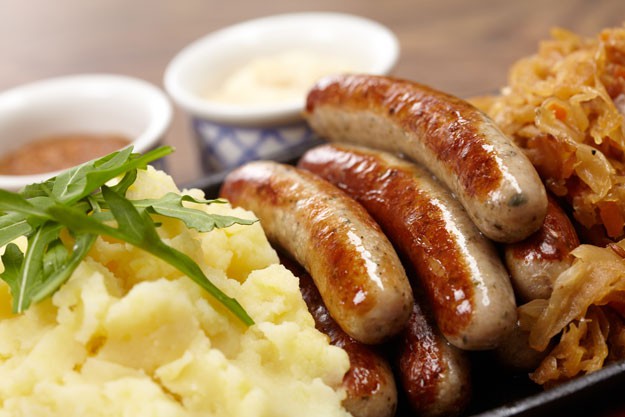Welcome back to our comprehensive guide on How To Be A Master Chef for beginners and food enthusiasts! In today’s posts, we’ll go over the most important meal of the day: breakfast! Learn how to properly eggs and morning meats! proper braising & stewing techniques, as well as how to properly spice your foods. If you’ve ever wanted to be a master chef, the time is now, so let’s get started!
Did you miss our guide on baking? Learn how to make Pies, Cakes & Quick Breads like a master baker!
Become A Master At Making Breakfast

Breakfast… the most important meal of the day! This meal is vital in giving you the energy you need to do what you need to do throughout the day, meaning you should probably know how to cook it. In this post, you will learn to cook farm-fresh eggs, morning meats, and bread. Read on to become a breakfast master!
Becoming An Egg-spert
These are the best start to any morning! Packed with protein, eggs are great for anyone who enjoys a savory breakfast. This section will go over the different specialty eggs and how to poach, fry, boil, and fold them!
Know Your Eggs
There are tons of choices when picking out eggs, but which ones should you get? There are so many types that they might make your head spin, so here are some definitions to allow you to make a wise decision on choosing eggs:
Free-Range Eggs: These eggs are exactly how they sound. The mothers (hens) are given a bit of freedom. Most of the chickens on free-ranges do not even leave the buildings on the property, meaning there really isn’t much of a difference. These chickens are not in cages, meaning they probably have a higher quality of life, but the eggs don’t really taste any different.
Eggs With Added Omega-3s: Omega 3s are fatty acids that are supposed be beneficial to heart health. These eggs also have a higher vitamin E content. The hens are given a diet that is higher in omega-3s, giving their eggs more of the healthy fats we need.
Organic Eggs: The chickens making these eggs are not given any drugs, antibiotics, animal byproducts, or hormones. Some believe that this makes the eggs safer and purer. A lot of people also claim the eggs are more nutritious, but there is not a lot of evidence proving this to be accurate.
Cooking Eggs
Scrambled: Mix up the raw eggs in a bowl, pour some milk in the mix, butter a skillet and cook until they firm up. This takes only a few minutes, and the result is delicious. Toss some cheese on them while they are cooking for some added flavor!
Fried: Break an egg into a hot, oiled skillet and allow it to cook until it is firm. The whites will turn a solid white, and the yolk can be cooked until you feel it is cooked to your preference. You can also place a lid over the skillet to make the egg cook faster.
Poached: These are cooked in boiling water. To poach an egg, you will need a saucepan and a slotted spoon. Fill the saucepan halfway with water and bring it to a simmer. Add a tablespoon of white vinegar to the water once it is simmering. Next, break an egg into a cup or bowl. Stir the water with the slotted spoon to create a whirlpool in the saucepan. As it is being stirred, gently pour the egg from the cup into the middle of the whirlpool. Allow this to cook for 3 minutes and take the egg out with the slotted spoon. This is best served on an English muffin or toast.
Boiled: Hard-boiled eggs are delicious and easy to bring as a snack. To see how to cook a hard boiled egg, look at Chapter 5.
Folded: Folding omelets is not only pretty, but easy as well. Cooking an omelet properly will result in a smooth outside with a moist center. Add anything you want to add into your fold. Simply take scrambled eggs, coat a hot pan with them. Once they are firm enough, add your ingredients and fold it over using a spatula.
Mandatory Morning Meats

We love the meats! What’s breakfast without bacon, sausage, ham, and any other greasy delicious meat you can think of? This section will go over how the breakfast meats and how to cook them.
Bacon
Crispy, smoky bacon can make any meal better. Traditionally known as a breakfast meat, this meat goes well with eggs, but it goes great with anything! There are many different types of bacon, so just choose one that meets your tastes (we love maple bacon!). Most people fry their bacon by putting it on the stove. When frying, make sure to do it on low heat to avoid grease splatters. Also, this should ensure it won’t burn. Once it looks like it is getting crispy, flip it and cook the other side. If you want to bake your bacon, put it on a baking pan in a preheated 400-degree oven for 10 to 15 minutes. The bacon should be good to go. You can also microwave bacon (although we don’t recommend it). Put the bacon between paper towels on a microwave-safe plate and put it on high for a minute per slice.
Savory Breakfast Sausage
Patties, links, and crumbles… oh my! Breakfast sausage is the perfect add-on to your breakfast. It is fatty, delicious, and well-spiced. Fry links and patties in a skillet over medium heat and turn them every couple of minutes. Once the surface is golden brown, and the center is brown and hot, they are done.
Steak Is Never A Mistake!
Beef for breakfast? Yes! Small steaks are great with eggs and provide a ton of calories to get you through a rough day. Serve the steak up with some eggs and hash-browns and you’ve got yourself a breakfast!
Great breakfast means you have to have great coffee! Learn how to make pour over coffee with this Pour Over Coffee Brew Guide for Beginners!
Follow the Table of Contents to catch up on our series or refresh your culinary memory:
Chapter 1: Be A Master Chef in 10 Days
Chapter 2: Kitchen Storage Ideas
Chapter 2.1: Main Kitchen Appliances
Chapter 2.2: Creating a Safe and User-Friendly Kitchen
Chapter 2.3: Essential Pots, Pans and Cookware
Chapter 3: How To Organize and Stock Your Kitchen Pantry
Chapter 4: How To Buy and Use Your Kitchen Knives
Chapter 4.1: Knife Cuts – Chopping, Dicing and More
Chapter 5: How To Steam, Boil, Poach and More
Chapter 6: How To Saute and Make Homemade Sauces
Chapter 7: How To Braise Meat and How To Make Stew
Chapter 8: How To Roast Meat, Veggies and Poultry
Chapter 9: How To Grill Steak, Chicken and Veggies
Chapter 10: How To Bake Goods and Desserts From Scratch
Chapter 10.1: How to Make Pie Crust, How To Bake Cakes and More!
Chapter 11: Cooking for Beginners – Breakfast
Chapter 11.1: Breakfast Bread – How To Make French Toast, Pancakes & Waffles
Chapter 13: How To Cook Perfect Pasta and Hearty Grains
Chapter 14: How To Make Sauces From Scratch
Chapter 15: Easy To Make Homemade Desserts For Beginners
Chapter 16: How To Make Single-Pot Recipes From Scratch
Chapter 17: Thinking Like A Chef – Cooking Tips for Beginners
Don’t forget to catch the next part of our guide to How To Be A Master Chef In 10 Days! We love hearing your feedback and comments, so let us know if you have any other tips for beginner cooks or your thoughts on this series. HomemadeRecipes.com was founded to create an online community where foodies, epicureans and chefs can share recipes and learn new ones! We need your help, however, in creating this community where you can come, share and learn. If you love to cook, love food or have some great recipes and ideas you’d like to share with us, shoot us an email and make sure to stay in touch on Facebook, Twitter, and Pinterest! We’re always looking for contributors and want to hear from you.
Sign up for our daily newsletter here!
Do you have Instagram? Don’t forget to follow @HomemadeRecipesOfficial.
Click here to Like Us on Facebook.
Click here to Follow Homemade Recipes on Pinterest



Leave a Reply